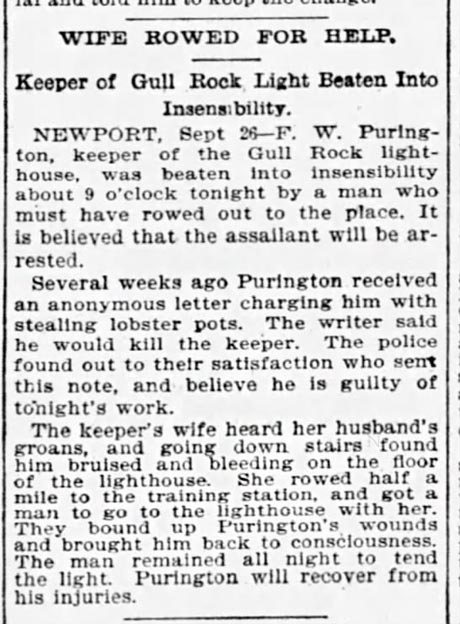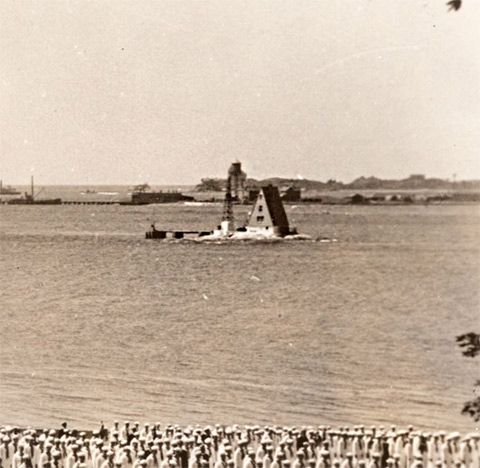In 1885 the Lighthouse Board wanted to replace the Old Colony light with a government lighthouse. It would be two years before Gull Rocks Lighthouse was built. The A-frame lighthouse was equipped with two post lanterns. They were hung from the gables on the east side and west side of the lighthouse. They were replaced by more powerful lens lanterns in 1899. In 1928, the twin lights were replaced with a single light on a 45 foot skeleton tower.
Frederick Purington was appointed Gull Rocks Lighthouse's first keeper in 1887. It appeared he had an uneventful time there until 1894. An article in the September 27, 1894 edition of The Boston Globe said he was assaulted at the lighthouse. His wife was on the second floor when she heard her husband cry out. She ran downstairs and found her husband on the floor bleeding and unconscious. She rowed to the nearby Naval training station for help for her husband. A sailor went back to the lighthouse to help her husband.
 |
| Courtesy of The Boston Globe September 27, 1894 |
Purington had received an anonymous letter a few weeks earlier claiming he had stolen lobster pots. The writer said he was going to kill him. The police found out who sent the letter and believed he was the attacker.
An article in a local paper, the Fall River Daily Evening News, also on September 27, 1894 suggested a different reason for the attack. It stated the attacker, Frank Cooper, and Purington's wife were having an affair. Cooper was arrested the same day. He was detained by the Newport Police and held on ten thousand dollars bail. This was to keep him in custody for Federal authorities. Gull Rocks Lighthouse was on Federal land and he could not be charged by Newport or Rhode Island authorities.
Some people in Newport believed Cooper was innocent and had seen him in Newport for a large part of the night that Purington was assaulted. He was released from jail a couple of days later.
On October 1, 1894 Purington picked up his pay and took off. His wife was left in charge of the lighthouse. An article in the October 4, 1894 edition of the Fall River Globe suggested she may have been abused. It stated, " Another lightkeeper says she came to him a few nights since, having been chased off Gull Rock at the point of a shotgun."
| Gull Rocks Lighthouse 1890s |
|---|
 |
| "Newport Harbor with Artist", VM013_GF6261, Rhode Island Photograph Collection , Providence Public Library, Providence, RI licensed under CC BY-SA 4.0 |
I believe the Lighthouse Board may have felt sorry for her and would have made her Gull Rocks' keeper, if she had wanted it. They waited almost a month to find a replacement. They were going to send Bristol Ferry's Keeper Edward Sherman but changed their minds. The new keeper, Adolph Obman, was appointed on November 20, 1894. He had been a mate on the Hog Island Shoal Lightship.
On May 10, 1896 a boat went to Gull Rock Lighthouse. The men in it started to bother Obman's wife. She rang the fog bell to get help. After the bell rang for several hours, a crew from the Naval training station went to investigate. The men had left before the crew arrived. One of the Navy men was left to guard the light until sun rise.
Gull Rocks Lighthouse was converted from acetylene gas to electricity on July 18, 1956. The electricity came from an underwater cable from the nearby navy base. The electricity brought improvements to the light and life at Gull Rocks. The light was increased from 120 candlepower to 900 candlepower. It also cut down on the light's maintenance. The keepers had to constantly clean the gas burning apparatus. The light was also equipped with a backup generator in case the power from the nearby navy base failed. The keeper's lives were also easier with electricity, as they could finally watch television. The fog bell was now rung automatically. Before it ran on a clockwork mechanism the keepers had to wind up.
In 1960 the Coast Guard decided to automate Gull Rocks lighthouse because its living facilities were antiquated and it would cost too much to renovate them. The lighthouse was closed as a manned lighthouse at 4:30 p.m. on September 8, 1960 when its three man crew left. The lighthouse was controlled from the nearby Rose Island Lighthouse. The light was increased to 1800 candlepower during the automation.
In 1961 the Coast Guard hired The Newport Demolition Company to destroy Gull Rock lighthouse because it wasn't needed anymore.. It was burned on July 12. While it burned many people called the police and fire departments to report it. When they were told it was being legally burned, many said "It's a shame; it such a pretty thing out there in the harbor." All that remained of the lighthouse was an oil house and a concrete pier.
When the Newport Bridge was completed in 1969, the light was no longer needed because boats couldn't travel under the low deck of the bridge on the East Side of the bay and it was turned off. On January 8, 1970 a Coast Guard helicopter removed the light and flew it to the Bristol Coast Guard Depot.
Newport Bridge Construction (1967) Showing Gull Rock Light
The site of Gull Rocks Lighthouse was declared surplus by the federal government in 1972. It was offered free to any state and local government and eligible non-profit institutions for public use. Some of the public uses listed were a public park or recreation area, a school or education use, or for the protection of the public health. On August 3 Newport's recreation director, Daniel J McCarthy, and Robert Reed, a registered real estate appraiser inspected the site. In a letter to the Newport City Council they said "It is our joint opinion that this small area had no potential for recreational use without a large expenditure of funds for cleaning and docking facilities ... We believe it is not practical for the city to purchase of so-called Gull Rock,"
In 1973 after Rhode Island and Newport refused to take Gull Rocks, the General Services Administration offered it for sale. Sixty people bid on it. The bids were opened October 12. The high bid was submitted by Frank Manuella. His bid was $3,462. An article in the November 2, 1973 issue of the Newport Mercury, said Manuella, an artist, had plans to decorate it with an eternal one-man one piece show.
In 2012 I saw a for sale sign leaning against the oil house. The asking price for it was $195,000. It remained on the market until 2015, when it was sold for $95,000.
| Gull Rock Lighthouse in 1900 |
|---|
 |
| Courtesy of N.L. Stebbins |

